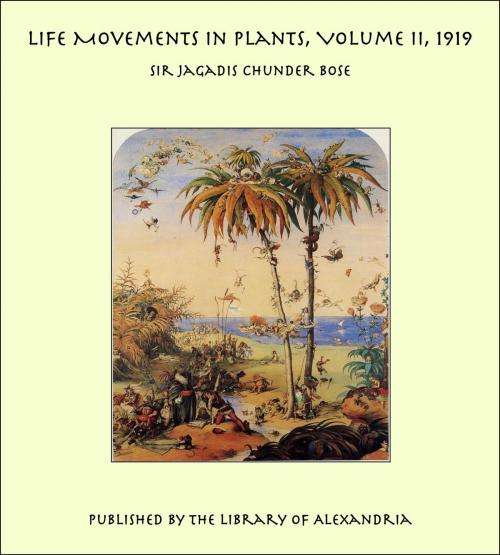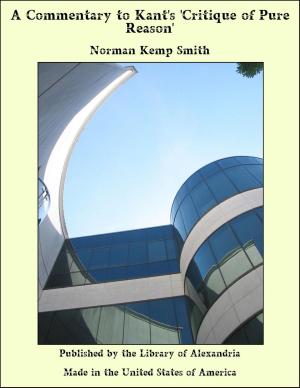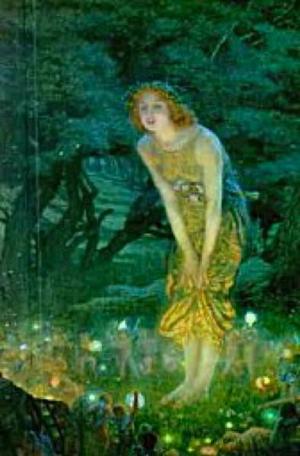Life Movements in Plants, Volume II, 1919
Nonfiction, Religion & Spirituality, New Age, History, Fiction & Literature| Author: | Sir Jagadis Chunder Bose | ISBN: | 9781465543486 |
| Publisher: | Library of Alexandria | Publication: | March 8, 2015 |
| Imprint: | Language: | English |
| Author: | Sir Jagadis Chunder Bose |
| ISBN: | 9781465543486 |
| Publisher: | Library of Alexandria |
| Publication: | March 8, 2015 |
| Imprint: | |
| Language: | English |
I have in the present volume dealt with the intricate phenomena of different tropisms. The movements in plants under the stimuli of the environment—the twining of tendrils, the effect of temperature, the action of light inducing movements sometimes towards and at other times away from the stimulus, the diametrically opposite responses of the shoot and the root to the same stimulus of gravity, the day and night positions of organs of plants—these, and many others present such diversities that it must have appeared a hopeless endeavour to discover any fundamental reaction applicable in all cases. It has therefore been customary to assume different sensibilities especially evolved for the advantage of the plant. But teleological argument and the use of descriptive phrases, like positive and negative tropism, offer no real explanation of the phenomena. Thus to quote Pfeffer "When we say that an organ curves towards a source of illumination, because of its heliotropic irritability we are simply expressing an ascertained fact in a conveniently abbreviated form, without explaining why such curvature is possible or how it is produced.... Many observers have unfortunately devoted their attention to artificially classifying the phenomenon observed, and have entirely neglected the explanation of causes underlying them." He also adds that in regard to the phenomenon of growth and its variations, an empirical treatment is all that is possible in the present state of our knowledge; but deduction from results of experimental investigation "still remains the ideal of physiology, and only when this ideal has been attained, shall we be able to obtain a comprehensive view of the interacting factors at work in the living organism." In my previous work on "Plant Response" (1906) I described detailed investigations on irritability of plants which I carried out with highly sensitive recorders. The plant was thus made to tell its own story by means of its self-made records. The results showed that there is no specific difference in physiological reaction of different organs to justify the assumption of positive and negative irritabilities. A generalisation was obtained which gave a complete explanation of diverse movements in plants. The results were fully confirmed by an independent method of inquiry, namely that of electric response, which I have been able to elaborate so as to become a very important means of research. The investigations described in the present volume not only support the conclusions reached in my earlier works, but have led to important additions. It is evident that the range of our investigation is limited only by our power of recording the rate of plant-movement, that is to say, in the measurement of length and time. In these respects the instruments that I have been able to devise have surpassed my sanguine expectations. The Resonant Recorder traces time-intervals as short as a thousandth part of a second, while my Balanced Crescograph enables us to measure variation of rate of growth as minute as 1/1000 millionth of an inch per second, the sensitiveness of this apparatus thus rivals that of the spectroscope. The increasing refinement in our experimental methods cannot but lead to important advances towards a deeper understanding of underlying reactions in the living organism. I shall here draw attention to only a few of the important results given in the present volume. The tropic effect of light has been shown to have a definite relation to the quantity of incident light. A complete tropic curve has been obtained from sub-minimal to maximal stimulation which shows the inadequacy of Weber's law, for the sub-minimal stimulus induces a qualitative difference in physiological reaction. It has further been shown that the prevalent idea that perception and heliotropic excitation are two distinct phenomena is without any foundation
I have in the present volume dealt with the intricate phenomena of different tropisms. The movements in plants under the stimuli of the environment—the twining of tendrils, the effect of temperature, the action of light inducing movements sometimes towards and at other times away from the stimulus, the diametrically opposite responses of the shoot and the root to the same stimulus of gravity, the day and night positions of organs of plants—these, and many others present such diversities that it must have appeared a hopeless endeavour to discover any fundamental reaction applicable in all cases. It has therefore been customary to assume different sensibilities especially evolved for the advantage of the plant. But teleological argument and the use of descriptive phrases, like positive and negative tropism, offer no real explanation of the phenomena. Thus to quote Pfeffer "When we say that an organ curves towards a source of illumination, because of its heliotropic irritability we are simply expressing an ascertained fact in a conveniently abbreviated form, without explaining why such curvature is possible or how it is produced.... Many observers have unfortunately devoted their attention to artificially classifying the phenomenon observed, and have entirely neglected the explanation of causes underlying them." He also adds that in regard to the phenomenon of growth and its variations, an empirical treatment is all that is possible in the present state of our knowledge; but deduction from results of experimental investigation "still remains the ideal of physiology, and only when this ideal has been attained, shall we be able to obtain a comprehensive view of the interacting factors at work in the living organism." In my previous work on "Plant Response" (1906) I described detailed investigations on irritability of plants which I carried out with highly sensitive recorders. The plant was thus made to tell its own story by means of its self-made records. The results showed that there is no specific difference in physiological reaction of different organs to justify the assumption of positive and negative irritabilities. A generalisation was obtained which gave a complete explanation of diverse movements in plants. The results were fully confirmed by an independent method of inquiry, namely that of electric response, which I have been able to elaborate so as to become a very important means of research. The investigations described in the present volume not only support the conclusions reached in my earlier works, but have led to important additions. It is evident that the range of our investigation is limited only by our power of recording the rate of plant-movement, that is to say, in the measurement of length and time. In these respects the instruments that I have been able to devise have surpassed my sanguine expectations. The Resonant Recorder traces time-intervals as short as a thousandth part of a second, while my Balanced Crescograph enables us to measure variation of rate of growth as minute as 1/1000 millionth of an inch per second, the sensitiveness of this apparatus thus rivals that of the spectroscope. The increasing refinement in our experimental methods cannot but lead to important advances towards a deeper understanding of underlying reactions in the living organism. I shall here draw attention to only a few of the important results given in the present volume. The tropic effect of light has been shown to have a definite relation to the quantity of incident light. A complete tropic curve has been obtained from sub-minimal to maximal stimulation which shows the inadequacy of Weber's law, for the sub-minimal stimulus induces a qualitative difference in physiological reaction. It has further been shown that the prevalent idea that perception and heliotropic excitation are two distinct phenomena is without any foundation















